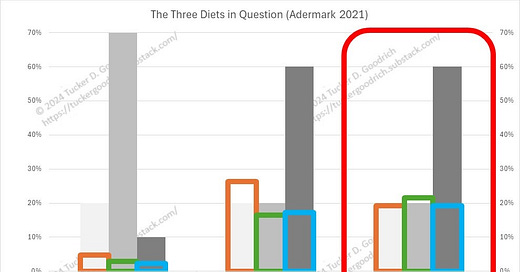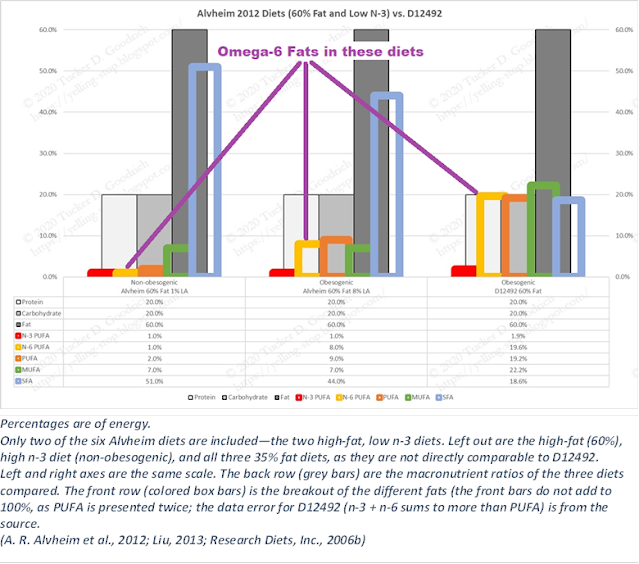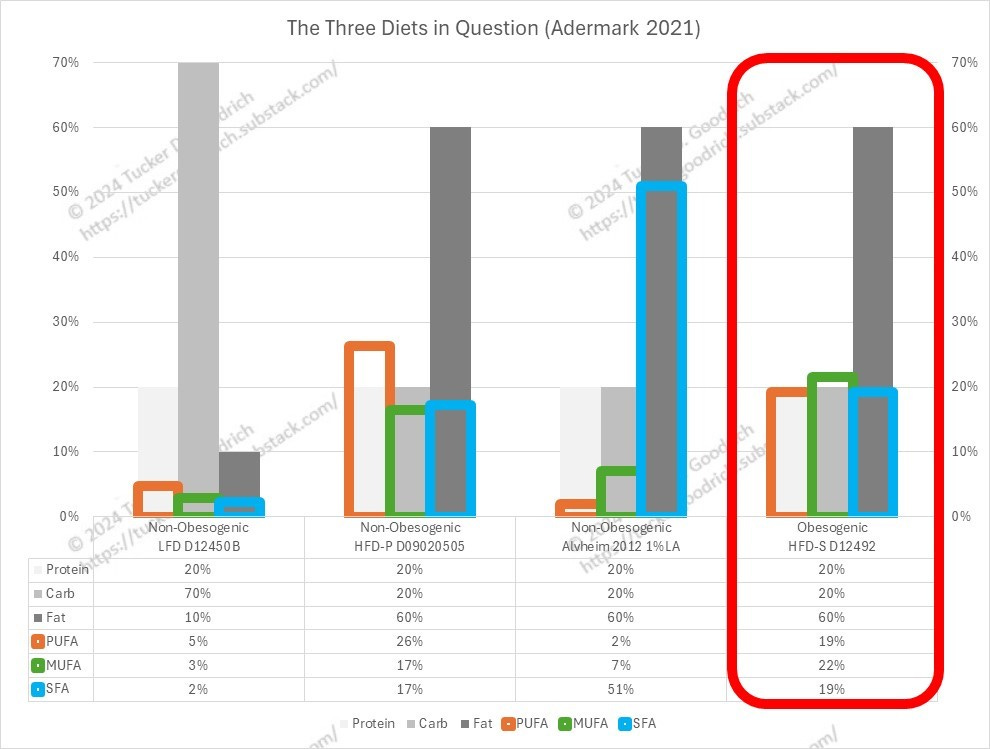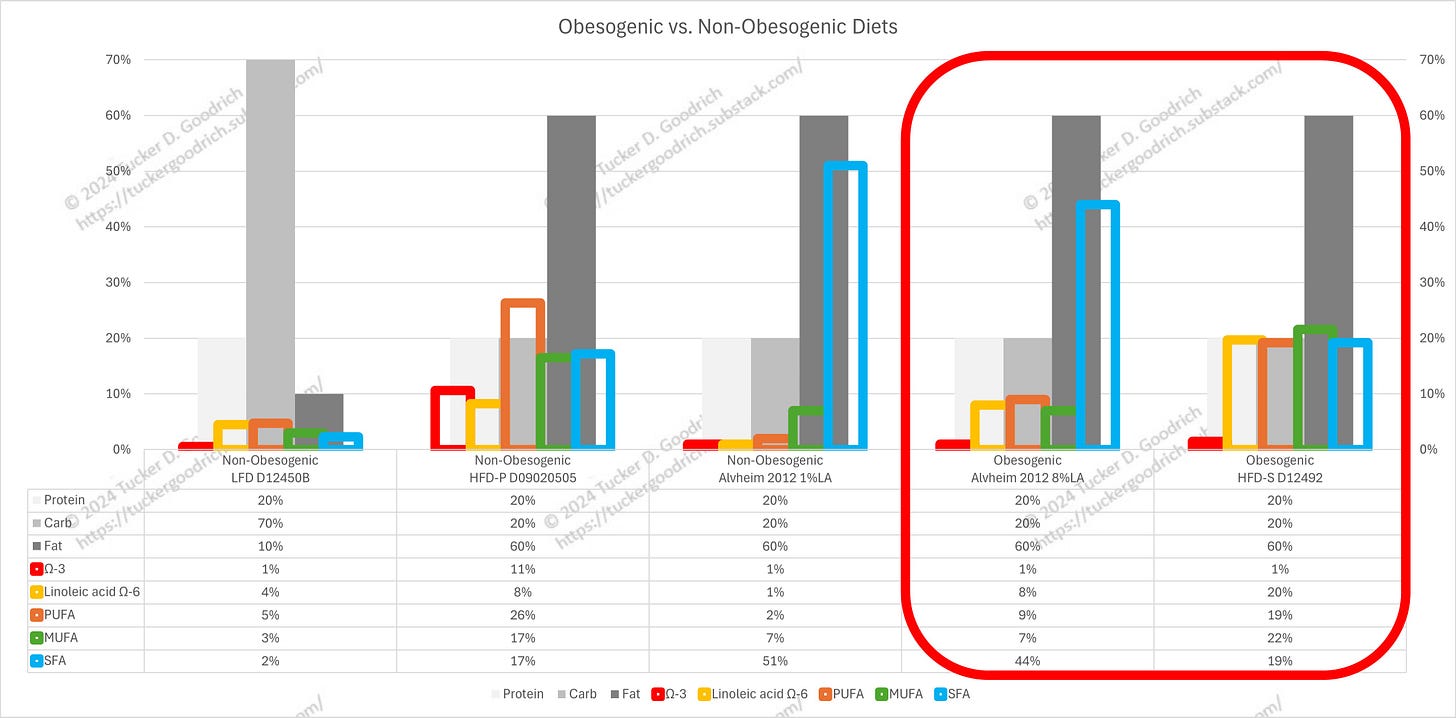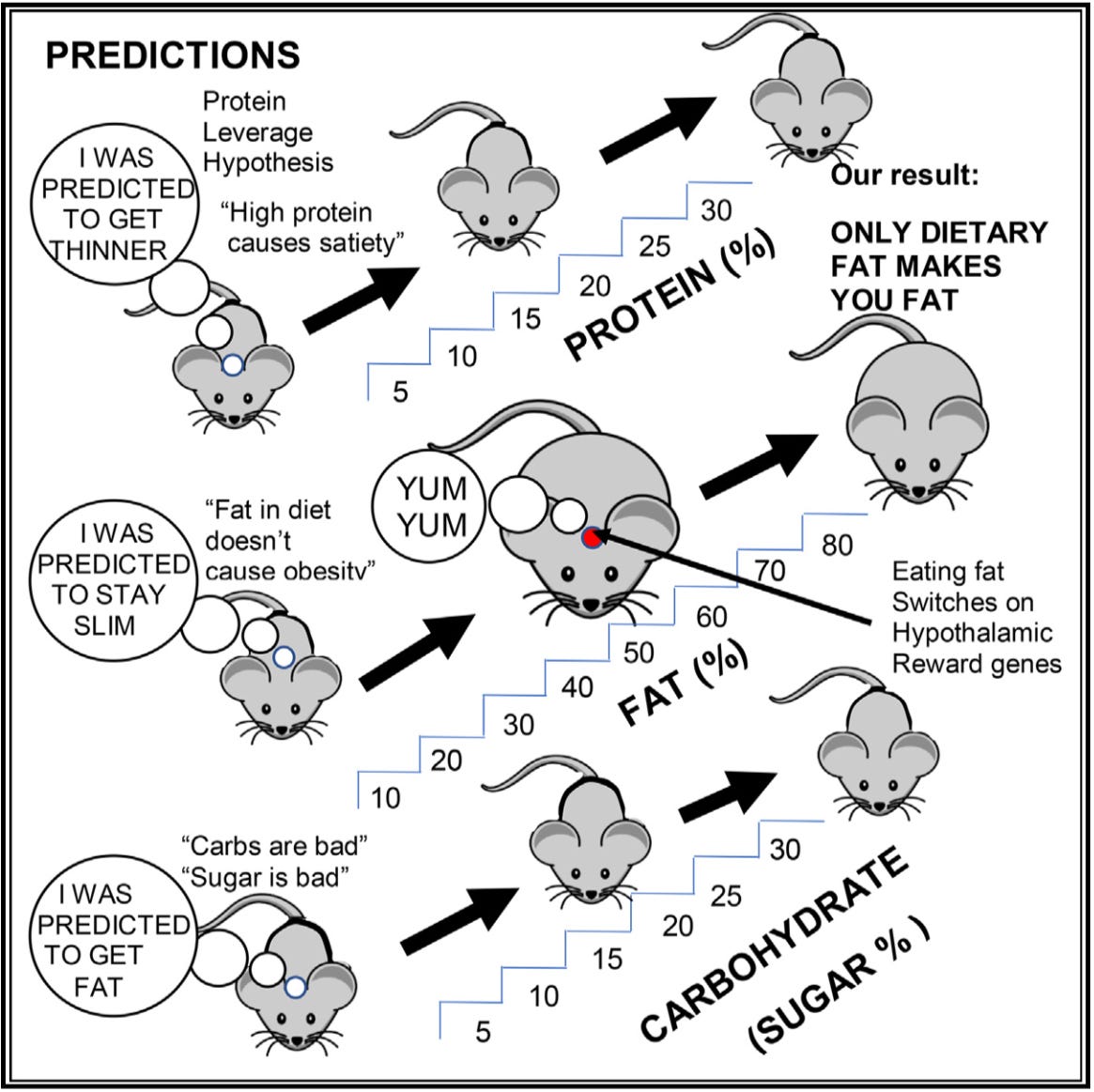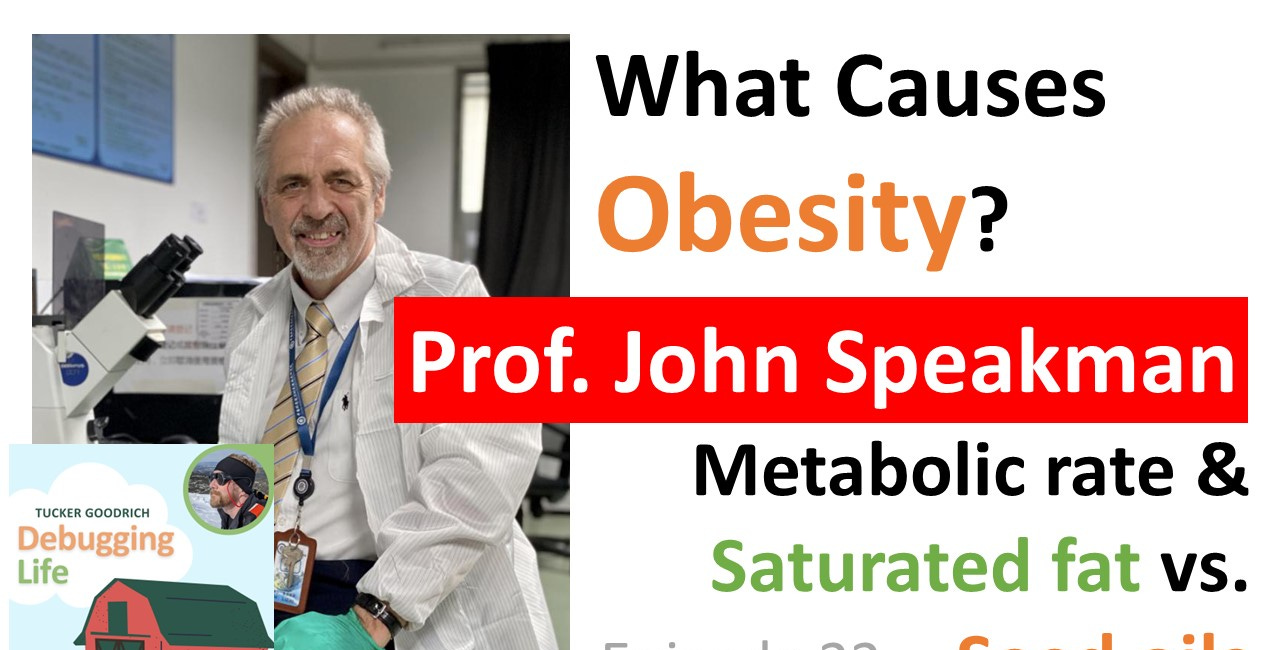Quick Study Analysis: The Fat Curve (Part 1)
This didn't turn out to be all that quick, but it's worth it.
Following up…
One always finds the best studies while one is looking for something else. Unfortunately, that usually ruins the work you are supposed to be doing, which today was getting the next podcast ready and getting ready for my in-laws arriving.
Sigh.
This is basically a follow-up to this post:
Does Linoleic Acid Induce Obesity? Part 1
[P.S. Part 2: Roux-en-Y Gastric Bypass and 4-Hydroxynonenal.] Introduction OK folks, into the wayback machine.Thanks for reading Tucker Goodrich: yelling Stop! Subscribe for free to receive new posts and support my work. In 2010 I stopped eating seed oils, and saw a chronic inflammatory bowel disease resolve in days:
Substack thoughtfully adds the graphic we’ll be looking at today to that link. Shortly.
Today’s paper is, “Weight Gain and Neuroadaptations Elicited by High Fat Diet Depend on Fatty Acid Composition” (Adermark 2021—I’m dropping the “et al.,” from now on).
Perfect!
We’re going to skip the “Neuroadaptations” part of this, although I’m sure that’s interesting.
Adermark looks at the effect of three diets, all from Research Diets.
Bait and Switch
A Low-Fat Diet (LFD), D12450B; a High-Fat Diet, which they characterize as “Saturated”, (HFD-S), conveniently D12492, the cookie-dough diet we all love; and a High-Fat Diet, “Polyunsaturated” (HFD-P) which is a new one to me, D09020505. (Links to all in References.)
“Outlining neurophysiological adaptations induced by dietary intake of high fat diets (HFD) is thus valuable to establish how the diet by itself may promote overeating. To this end, C57BL/6 mice were fed HFD rich in either saturated fatty acids (HFD-S) or polyunsaturated fatty acids (HFD-P), or a low-fat control diet (LFD) for four weeks.”
So they portray this as a comparison of saturated vs. polyunsaturated diets: the great fatty battle of our time.
As you can see from the chart, I have helpfully labeled and highlighted in red the saturated-fat diet. It’s obesogenic.
What’s odd is that it’s 19% of energy from saturated fat. The non-obesogenic, polyunsaturated diet HFD-P is not obesogenic. It has 17% of energy from saturated fat.
Additionally, the LFD, which only has 2% of energy from saturated fat, is also non-obesogenic
It’s remarkable that you can go from 2% of energy to 17% of energy, and nothing happens—no obesity—and then suddenly, another 2% saturated fat to 19% of energy, and these poor mice bloat out (HFD-S, in the middle above).
What would happen if, say, we fed mice 51% of energy from saturated fat?
The third column, added to the chart above, shows a 51% saturated, 2% polyunsaturated diet.
Saturated fat is not obesogenic
It is not obesogenic.
This is from Alvheim in 2012, where they looked at a variety of diets and altered the fatty acid balance between polyunsatured fats of various types, and saturated fat. I discussed this paper at length in my Obesity post (linked above). So while Adermark would have you believe that the obesogenic fat is saturated fat, Alvheim showed that’s not the case. (And it’s not really plausible based on Adermark’s 2% increase in saturated fat, either.)
The significant difference between Adermark’s HFD-S and HFD-P diets is:
“However, in HFD-P 69% of the lard, which was the source of saturated fat in HFD-S, was exchanged for menhaden oil (a source of PUFA).” (Diet details in (Svahn, 2015).)
In my interview with Tony Hulbert, he said he doesn’t think we should ever use the term “PUFA”, and this paper is a fine example of why.
Ep. 15: A.J. Hulbert on the Omega Balance—with Dr. Brian Kerley
Introduction We are honorored to be joined by Prof. A. J. Hulbert, noted zoologist and author of Omega Balance: Nutritional Power for a Happier, Healthier Life. “In Omega Balance, noted scientist Anthony J. Hulbert explains how the balance between [Omega-3 and omega-6 fatty acids] in the human food chain has changed over the last half-century and the very…
In Alvheim, they demonstrated that increasing PUFA from 2% to 9%, and decreasing SFA from 51% to 44%, caused a diet to change from non-obesogenic to obesogenic. See column 4, below.
They then demonstrating that adding Ω-3 PUFA, from fish oil, caused the obesogenic diet to revert (mostly) to non-obesogenic.
Adermark has essentially replicated that experiment, by switching from high-Ω-6 lard to high-Ω-3 fish oil, they lowered Ω-6 and increased Ω-3, this improving the omega balance. (They do not cite Alvheim or mention linoleic acid.)
In the graph above I added those two fats as distinct items, and you can see that switch made a huge difference—column five vs. column two.
It also meant that the HFD-P mice, while eating much more fat than the LFD mice did, didn’t get obese. And they ate more food by weight or by calories than either other group of mice.
So the true story in this paper, is that Ω-6 PUFA fats are obesogenic, and the Ω-3 PUFA fats are protective.
The Fat Curve
Unfortunately, there are confounders. The 4% Ω-6 in the LFD diet does not induce obesity, while other, higher fat diets see an Ω-6-driven obesity in a higher-fat, lower-Ω-6 diet. I discussed one such diet, the Surwit diet, in the 4-Hydroxynonenal (HNE) section of the second part of my obesity post.
Does Linoleic Acid Induce Obesity? Part 2: Roux-en-Y Gastric Bypass and 4-Hydroxynonenal
Part 1 here. Roux-en-Y Gastric Bypass (RYGB) After Roux-en-Y bypass surgery, people show "a marked reduction of the hedonic drive to consume palatable food and beneficial changes in dietary habits." RYGB excludes from food contact the primary part of the small intestine that mediates food reward.
I additionally noted that a ketogenic diet takes you to the opposite end of the fat curve, where a high fat intake, even with high Ω-6, is not obesogenic.
I discussed this with John Speakman, who did one of the more interesting papers in this area.
Ep. 22: John Speakman—What Causes Obesity?
Introduction I am honored to be joined by John Speakman, a leading authority on energy balance in animals, and in the use of the doubly-labeled water method of determining energy balance. This has led him into the study of obesity, among other topics, where he has become a recognized expert.
So what protected the mice in the HFD-P diet from obesity? Was it something about the Ω-3 fats being rancid?
“Interestingly, mice fed HFD-P consumed more food than LFD- and HFD-S-fed mice. The increased food intake in mice fed HFD-P did not start immediately after introducing the diet, but was evident after approximately one week. Possibly, HFD-P fed mice required a period of adaptation to this diet, which has a distinct odor and texture. It is also possible that the mechanisms behind the promotion of food intake by HFD-P require some days to be noticeable. After the initial adaptation time, mice fed HFD-P had an increased daily energy intake compared to both mice fed LFD and those fed HFD-S.” (Adermark 2021)
Or was it the interplay between the two fats in membranes, as Hulbert suggests?
Interesting questions, for another time.
References
Adermark, L., Gutierrez, S., Lagström, O., Hammarlund, M., Licheri, V., & Johansson, M. E. (2021). Weight Gain and Neuroadaptations Elicited by High Fat Diet Depend on Fatty Acid Composition. Psychoneuroendocrinology, 126, 105143. https://doi.org/10.1016/j.psyneuen.2021.105143
Alvheim, A. R., Malde, M. K., Osei‐Hyiaman, D., Hong, Y. H., Pawlosky, R. J., Madsen, L., Kristiansen, K., Frøyland, L., & Hibbeln, J. R. (2012). Dietary Linoleic Acid Elevates Endogenous 2-AG and Anandamide and Induces Obesity. Obesity, 20(10), 1984–1994. https://doi.org/10.1038/oby.2012.38
Research Diets, Inc. (2006). D12450B Formula [Advertisement]. D12450B. https://researchdiets.com/formulas/d12450b
Research Diets, Inc. (2006). D12492 Formula [Advertisement]. Research Diets, Inc.: D12492: Rodent Diet With 60 Kcal% Fat. https://researchdiets.com/formulas/d12492
Research Diets, Inc. (2015). D09020505 Formula [Advertisement]. Research Diets, Inc. https://researchdiets.com/en/formulas/d09020505
Svahn, S. L., Grahnemo, L., Pálsdóttir, V., Nookaew, I., Wendt, K., Gabrielsson, B., Schéle, E., Benrick, A., Andersson, N., Nilsson, S., Johansson, M. E., & Jansson, J.-O. (2015). Dietary Polyunsaturated Fatty Acids Increase Survival and Decrease Bacterial Load During Septic Staphylococcus Aureus Infection and Improve Neutrophil Function in Mice. Infection and Immunity, 83(2), 514–521. https://doi.org/10.1128/IAI.02349-1-4


